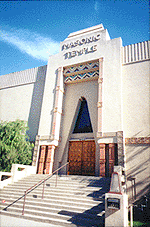 |
| Robert Stacy Judd, Templo Masónico de North Hollywood, California, 1946-51 (tarjeta postal) |

[ Principal | Índice general | Directorio | Condiciones de publicación | Objetivos | Correo ]
A Fevered Dream of
Maya: Robert Stacy-Judd
Jesse Lerner
Mayo, Año 2000
 |
| Robert Stacy Judd, Templo Masónico de North Hollywood, California, 1946-51 (tarjeta postal) |
Robert Stacy-Judd (1884-1975) came to learn of Maya architecture through Catherwood's etchings. Having made this discovery, he abandoned his youthful flirtations with other "exotic" architectural styles: ancient Egypt (Electric Picture Palace, Isle of Wight, 1910-12; Beni-Hasan Theater, Store and Office Building, Arcadia, CA, 1923-24), Tudor England (Elks Home, Williston, North Dakota, 1914-15), and the Islamic Middle East (in his designs for a 1916 auto show in North Dakota).(4) The ancient Maya, as evoked by his Aztec Hotel, were not a phase for Stacy-Judd, but a lifelong fascination. He filtered his perceptions of the ancient Maya through esoteric ideas about the spiritual power of the ruins. Unlike other more formalist and modernistappropriations of the Pre-Columbian past, such as those by Frank Lloyd Wright, Stacy-Judd's building reveal a sensibility which is more theatrical than architectural. Stacy-Judd saw in the Maya the mawkish story of a lost Eden, enlivened by royalty and pomp, which he dramatized in colorful costumes, flamboyant architecture, romantic poetry, and speculative literature. His greatest triumph was the Aztec Hotel (Monrovia, CA, 1924-25), which achieved overwhelming popular success, and earned praise in publications ranging from the New York Times to the trade magazines American Architect and The Hotel Monthly. It was the Aztec Hotel which launched Stacy-Judd's career as a promoter, explorer and chronicler of the ancient Maya.(5)
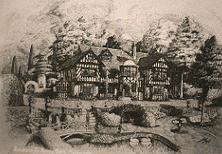 |
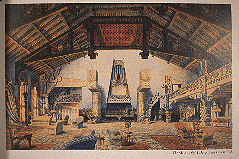 |
| Robert Stacy-Judd, Emery Mapes Residence, 1914, Minneapolis, Minnesota (proyecto). Archivo de la Universidad de California, Santa Barbara. | Robert Stacy-Judd, The Maya Lobby, La Jolla Beach and Yatch Club, 1926-1927. Archivo de la Universidad de California, Santa Barbara. |
the Hollywood crowd. Bette Davis turned to him to satiate her curiosity about the Maya. He even proposed a feature-length fiction film set at Chichén Itzá called The Scarlet Empressfor which he labored in his later years on costumes and sets.(6) Without the opportunity to produce this technicolor melodrama, without commissions for anything other than prosaic San Fernando Valley ranch houses, in the forties and fifties Stacy-Judd's imagination ran wild at the drafting board. He conjured up a number of fantastic, never-completed projects, such as the proto-Epcot Center village of Native American reinterpretations called the "Enchanted Boundary". None of his later projects ever garnered the high praise which the Aztec Hotel won for him. How was it that this Monrovia hostel captured the imagination of so many? The 1925 Aztec Hotel embodies the "enormous vogue for things Mexican,"(7) and represents a turning point in the history of the Maya Revival Style in the United States, distinct from both the more imperial era which it followed and the "Good Neighbor" phase, which coincided with the Second World War.
Earlier efforts to revive Ancient Maya building styles in the United States coincided with and embodied the spirit of a period of hemispheric expansion. Following the territorial enlargement resulting from the U.S.-Mexican and Spanish-American Wars, North Americans flocked to exhibitions where they could see something of these recent, distant acquisitions. These included displays of human specimens, antiquities, and plaster casts of archeological curiosities. P.T. Barnum was apparently responsible for a hoax which toured the U.S. and Europe, a pair of microcephalics billed as "descendants and specimens of the sacerdotal cast (now nearly extinct), of the Ancient Aztec founders of the ruined temples of that country, described by John L. Stephens Esq., and other travelers."(8) Barnum was not the only one hoping to capitalize on the success of Incidents . . .. In late 19th Century New York, the Globe Museum and the Orrin Brothers and Nichols Aztec Fair showed "the last descendants" of this ancient race.(9) This designation predicted the imminent demise of the Indian, recasting colonialism as preordained fate. The framing rhetoric positioned Pre-Cortesian America as a heritage available to be claimed, one without living heirs. In the Chicago's Columbian Exhibition, Edward Thompson's archeological casts included a life-sized copy of the arch at Labna. Standing guard is Desire Charnay's cast of Maya Indian, frozen in time like a fossilized human being.(10) The Indian was a thing of the past. The ruins were there for the taking. These displays embody the climate of westward expansion and Manifest Destiny which framed early American anthropology.(11) Thompson, who bought the ruins of Chichén-Itzá and smuggled gold and jade from its cenote (sacred well) and, and Augustus Le Plongeon, who harnessed a dozen of his Maya laborers to the stone Chac Mol in an aborted attempt to drag the object to Philadelphia, exemplify this acquisitive age. The removalof archeological loot went hand in hand with the search for raw materials, new markets, and land. The 1823 Monroe Doctrine set the tenor for a U.S. foreign policy premised on the belief that the hemisphere was ours.(12) The replicas of Maya ruins that constitute the origins of the revival style served as part of the symbolic turf-staking which buttressed this imperialist notion.(13)In contrast, by the late thirties the building of Maya Revival structures in the U.S. had gained an altogether different political urgency. The repeated U.S. invasions of Central America, the Carribean and Mexico in the second half of the 19th and early 20th Centuries had made Latin America suspicious and hostile to the colossus to the North. Wary of this ill-will, the Good Neighbor Policy of the Hoover and Roosevelt administrations championed policies of mutual respect, cooperation and non-intervention. The growing threat of fascism in Europe heightened the need for hemispheric unity.(14) Unlike the earlier unilateral appropriations, the exhibitions and recreations of ancient Mesoamerica in the U.S. in the 1930s and 1940s were typically collaborative efforts in which both the U.S. and Mexican governments participated.(15) Of this era, art historian Holly Barnet-Sanchez writes that "the United States government was not only seeking a rapprochement with all of Latin America but was also pursuing this policy within a clearly defined language of shared histories and cultures. Thus, by 1933 'the Other' had in effect become one of 'us'."(16) Architecture offered an ideal vehicle for this diplomatic move. Following the direction anticipated by the "Aztec Garden" of the Pan-American Union building (Albert Kelsey and Paul P. Cret, Washington, D.C., 1910), Maya Revival architecture made public declarations of a common American heritage. San Diego's former Federal Building (Richard Requa, 1935), a bit of Uxmal in Balboa Park, and Mérida's Parque de las Americas (Manuel Amábilis, 1946) where stelae naming the states of the Americas proclaim the shared Maya ancestry of nations including Canada, Uruguay and Cuba, embody this phenomenon. Neither diplomatic offering nor colonial proclamation of ownership, the Aztec Hotel represents a transitional moment in U.S. Neo-Mayanism, poised between the expansionism of the previous century and the diplomatic necessities of the Good Neighbor era.
Like P.T. Barnum's failure to distinguish between the Aztecs of Central Mexico and Stephens' account of the Maya ruins, the appellation "Aztec" for a building which is based on the peninsular "Maya" style represents a conflation of two very distinct regions and cultures of Mexico. The hotel's designation was not so much a misnomer as a concession to a North American public that may not have read Stephens' 1841 account. The ruins of Maya in Central America, Yucatan and Chiapas were less well known to the North American public than those of Aztecs of the Central Valley.(17) But that was changing. The twenties represents a high-water mark for the North American fascination for Mexican culture.(18) The opening of the Aztec Hotel coincides with a new visibility north of the border for Latin American culture generally and for Pre-Columbian objects and styles more specifically. In the 1920s, modernist dancer Ted Shawn toured middle America with Francisco Cornejo's costumes and Martha Graham's performance in Xochil, a Pre-Cortesian dance. Battery company executive and amateur Mayanist Theodore A Willard published his mannered archeological fiction, Bride of the Rain God: Princess of Chichen Itza and The City of the Sacred Well. Stacy-Judd's tour-de-force coincides with the inauguration of the Carnegie Institution's Chichén-Itzá excavations (1923-33), popularized in periodicals like the National Geographic.(19) Ann Axtel and Earl Morris published popular autobiographical accounts of their work with the Carnegie project. In 1923 the Yucatecan governor Felipe Carrillo Puerto opened a road connecting Chichén to the outside world.(20) As we shall see, Carrillo Puerto's motives for championing this Revolutionary Maya revival differed from those of the Carnegie, but in practice their agendas coincided. But of all these Jazz Age visions of the ancient Maya, none was more delirious than that of Stacy-Judd. His Monrovia Hotel opened to a United States primed for Pre-Columbian spectacle.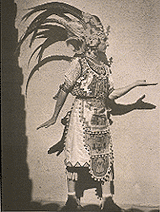 |
| Retrato de Robert Stacy-Judd. Archivo de la Universidad de California, Santa Barbara. |
The hype that developed around the Aztec Hotel (a good deal of which was instigated by Stacy-Judd himself) celebrated the Monrovia hostel as "the only building in the United States that is 100% American."(21) Turning to autochthonous sources was a frequent strategy for North Americans in search of an authentic, non-European identity. Often this search called for facepaints, secret rituals, and the taking of indigenous appellations. Posing in profile, as in a Maya bas-relief, Robert Stacy-Judd displays for the camera his Maya headdress and robes. By dressing himself as a Maya lord, the English expatriate engaged in a venerable American tradition of "playing Indian" that dates back to colonial times, if not earlier. Blackface and redface were old American strategies which served diverse functions.(22) Sometimes a disguise for rebellions which protested misrule, often a part of celebrations and ceremonies, and always an assertion of whiteness, this practice predates the Boston Tea Party.(23) Much like the rebellious Boston colonials, Stacy-Judd donned his Indian robes to cut the umbilical cord to Europe.(24) He joined members of the Improved Order of the Redmen, the New Confederacy of the Iroquois, and the Boy Scout's "Order of the Arrow" in a 100% American search for authenticity and rootedness through an aboriginal disguise.
Stacy-Judd's cross-cultural transvestism was much more than a single evening's act of symbolic rebellion. Building private houses and public buildings throughout the United States in the Neo-Maya style, Stacy-Judd always took his appropriation of the indigenous a step further. Stacy-Judd's was a double appropriation of alterity, paraphrasing, in a single structure, the Mexican and the Native American. The Indians are arguably that group whose names, likenesses, aesthetics, foods, dances, bodies, etc. are appropriated more often than any other ethnic group in the Americas, following on the theft of land and genocide which marked the European arrival in this hemisphere.(25) Within architecture, however, the appropriation of Native American forms was unusual in 1924, though precedents had been set by movie theaters (the Aztec Theater, Eagle Pass, TX, 1915) and at World's Fairs (the 1893 Columbian Exposition in the Chicago, the 1915 Panama California International Exposition in San Diego) and a few private homes.(26) By evoking autochthonous America, the Aztec Hotel anticipated the later Pueblo Deco style popular the 1930s.(27) Stacy-Judd's own Soboba Hot Springs Hotel and Indian Village (San Jacinto, 1924-27), with its Pima and Yuma cottages, a cocktail of Pueblo, Maricopa, and Hopi styles, probably represents the apogee of this short-lived architectural trend.(28) Appropriations of colonial Mexican architectural styles were more common. At the time Stacy-Judd designed the Aztec Hotel, the Mission Revival was at its apex in Southern California. Later he produced buildings like the Neil Monroe House (Sherwood Forest, CA, 1929), with eclectic blends of Mission and Maya elements. While Stacy-Judd's Aztec Hotel was not the first architectural appropriation of Ancient Mexico, the reference was unusual enough for him to make that claim.
Stacy-Judd's Aztec Hotel was built in the context of a generalized taste for architectural exoticism that flourished in Southern California in the twenties. It is linked not only to the Mission Revival in its regionalist evocation of a exalted history, but also to the other whimsical references to the exotic in the region, such as the Mann's Chinese Theater (Hollywood, 1927) or the Samson Tire Works (1929, today the Citadel outlet mall). Often the dialogue with the emerging cinema industry is pronounced, either in the building's function as movie palace or in references to distant locales, like the Babylonia of D. W. Griffith's Intolerance (1916) or Mexico-Tenochtitlan of C. B. De Mille's The Woman Who God Forgot (1917). Related too is the rise of the whimsical roadside vernacular architecture that Robert Venturi, Denise Scott Brown and Steven Izenour name "duck," in recognition of a Long Island diner shaped like (and specializing in roast) duck.(29) Contemporaneous Southern California structures such as the Brown Derby (1926), the Tamale (1928), Tijuana's Sombrero (1928) share a playful sense of building as symbol. Yet in spite of the relationships between the Aztec Hotel and these other examples of quirky, exoticized and movie-set architecture, Stacy-Judd found in the Maya more than simply a revival style. The deeper resonances of the image of Stacy-Judd in Maya costume evoke the ritual life of those millions of middle class American males involved secret societies and fraternal organizations.Especially in the 19th and early 20th Centuries, the Freemasons, the Knights of Pythias, the Odd Fellows, and hundreds of smaller groups offered ritual, conviviality, fellowship and entertainment to citizens in a society where social roles were in flux.(30) Members of these groups might impersonate Druids, Romans, or Native Americans in elaborate secret rites. One such group were the Mayan Temple and Alliance of American Aborigines of Brooklyn, New York, founded by Harold Davis Emerson, Ph.D., D.D. in 1928.(31) This temple, "similar to Masonry,"(32) offered ritual, dance, and classes on hieroglyphic writing to its members. Here was a natural constituency for the Maya Revival style. Though the Mayan Temple never had sufficient resources to commission their own building, they describe their quarters:
The Mayan Temple has now been completely redecorated. Through the courtesy of Chief Lynx and Brother Richard Bolanz picture writing and beautiful murals adorn the walls and ceilings. On the frieze in Indian picture-writing is the story of the Mayan Temple. Above it on the ceiling is the Mayan seal and the various clan totems . . . On the west wall is a reproduction of a Maya ruined city buried in the jungle.(33)Their newsletter provides an overview of the concerns of the Brooklyn Maya. News briefs report on the Carnegie Institution excavations and the evidence of ancient Maya use of the telegraph. Maya astrology is employed to predicted the future of Roosevelt's New Deal initiatives. Frequently articles dispel negative perceptions of the Indian as savage, backward, prone to practice human sacrifice, or violent. Credited or not, much of their account of the Maya is derived from the Le Plongeons.
For Masons and related groups, architecture was a subject of paramount importance. The Masonic quest for architectural perfection, embodied by the lost design of the Temple of Solomon, probably originates in their roots as Medieval British stone hewers.(34) This interest often led the Mason to paraphrase the ancient Egyptian monuments, sometimes on ambitious scale.(35) But followers of Augustus Le Plongeon, who argued the Egyptian mysteries originated with the peninsular Maya, turned to Native American architecture. Not surprisingly then many of the major patrons of Maya Revival
buildings are Masonic Lodges, from Mérida to North Hollywood, theosophical groups and other occult confederations. Robert Stacy-Judd found like-minded patron in the founder of the Philosophical Research Society, Manly Palmer Hall. Here the Maya Revival style embodied not Manifest Destiny, but an supernatural destiny made manifest.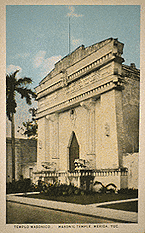 |
| Manuel Amábilis, Templo Masonico de Mérida, Yucatán, 1915 (tarjeta postal). |
Southern California is only one of the places where Stacy-Judd sought to promote his Maya Revival. The Stacy-Judd archive includes proposed projects in Mexico City, Ixtapalapi,(36) and Guatemala City. If the Maya Revival in Monrovia evoked the exoticism of distant pyramids, in Mexico the style took on completely different meanings. Encouraged by the success of the Aztec Hotel, Stacy-Judd set off to Yucatán to see the original models and to promote his designs. In Mérida he was invited to the office of the state governor, as he describes the visit in his travelogue:
My reason for visiting the Yucatan, primarily, was to further my efforts in creating an all-American architecture and its allied arts . . . For one whole hour the interview lasted. All things considered, the situation was extraordinary. I had been given to understand the Yucatecan to be indifferent to the potential wealth of his country, namely, the Mayan ruins. I was amazed to learn that, quite the contrary, he is vitally interested.Stacy-Judd's assumption that the modern Yucatecans were "indifferent" to the ruins echoes the writings of other European and North American travelers, including Stephens' own Incidents . . .These accounts consistently attempted to separate the ancient Maya and their spectacular cities from their contemporary descendants. Stephens had lamented "that so beautiful a country should be in such miserable hands." Though he rejected the wilder diffusionist theories that circulated widely at the time, he nonetheless believed that "no remnant of this race [of architects] hangs round the ruins."(38) Stacy-Judd learned this indifference was a self-serving misperception, propagated by writers like Stephens(39). Upon his arrival in Mérida, Stacy-Judd discovered that the contemporary Yucatecans were so "vitally interested" in their past that they had arrived at their own very different Maya Revival style independently of Stacy-Judd. The "Building of the People" ( La Casa del Pueblo), where the described appointment took place, is in the Maya Revival style. Though the building, designed by the Mexican architect Angel Balchini, was completed in 1928, the fact that Stacy-Judd mentions that the project was initiated by Carrillo Puerto (governor 1923-24) suggests he was aware that the building was almost exactly contemporary with his Aztec Hotel.(40) Stacy-Judd's strange silence here not only protects his claims as the first to revive the architecture of the ancient Maya, but also elides his own position as an importer of Maya architecture to its place of origin.After I had finally answered numerous inquiries regarding my adventures in Yucatan up to that time, the Governor asked to see my water color studies of Mayan adaptations. And when we finally parted, he said in his cordial manner, "Don't forget, Señor, our country is yours."
. . . Glancing back as I left the "Building of the People," my eye caught sight of an oil painting standing on an easel in the open foyer. It was an oil painting of the late General Carrillo, Governor of Yucatan. He it was who commenced this structure, intending it to be his residence--but alas! he was murdered in 1924, while in office.(37)
The Yucatecan version of the Maya Revival arguably predated the Mexican Revolution, but it was under that auspices of the Revolution that it flourished.(41) As such, it was part of a larger political and social program, one which used consciously used culture as a means to elevate the subaltern.(42) In the Yucatan, the Revolution came not as an organic uprising from below, but as an imported phenomenon.(43) The principal leaders, Salvador Alvarado and Felipe Carrillo Puerto, were in someways like caudillos [strongmen], a Leninist vanguard intent on jump-starting a radical social movement among the indigenous majority, still emerging from an oppressive system of debt-peonage bordering on slavery. Monuments and public buildings were an important part of their program to stir pride in the glorious Maya past. In spite of the massive immigration of Mexicans to Southern California in the twenties, accelerated by the push of Mexican domestic upheavals and the pull of labor shortages in the U.S., the Aztec Hotel only addresses an Anglo public.(44) If Stacy-Judd's use of ancient Maya motifs in Monrovia and elsewhere in Southern California are examples of a cultural appropriation of a geographically and historically distant Eden, in Mérida his project takes on an entirely different character, that of a repatriation, albeit one highly transformed.(45) During his stay in the Yucatán, Stacy-Judd came to know the Revolutionary socialist state's version of the Maya Revival. He was overwealmed:
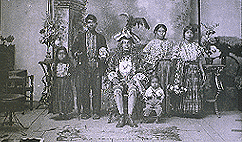 |
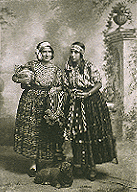 |
| Estudio fotográfico de Tomas Zanotti, Retrato de una familia maya vestida para el baile de la conquista. Archivo del Centro de Investigaciones Regionales de Mesoamérica | Estudio fotográfico de Tomas Zanotti, Retrato de dos muchachas ladinas disfrazadas de mayas. Archivo del Centro de Investigaciones Regionales de Mesoamerica |
Unlike those North American visitors who came as leftist pilgrims, Stacy-Judd took no notice of the radical social experiment underway.(47) What drew him was the costume drama of the Maya opera.There is plenty of evidence that the Yucatecan is awakening to an appreciation of the civilization whose extraordinary works lie buried in the jungle-growth fastness of his country. As one instance, the latest opera of Señor Luis Rosado Vega, Yucatan's favorite composer, was Mayan, and the night of its premiere production in Mérida was of red-letter importance. . .
The story told of the Nahuatl introduction among the Mayas of human sacrifice, and centered around the custom of presenting a beautiful virgin as bride to Yum Chac, the Rain God, in times of extreme drought, The scene of action was, of course, the now famous Sacred Well at Chichen-Itza. . .
The costume designs were accurate as to classical style and presented a gorgeous appearance. They were by far the outstanding features of the performance and more clearly exemplified the true ancient Maya than did either the music of the settings. No New Yorkstage fantasy ever surpassed in costuming the beauty and striking colorfulness expressed in these cleverly-conceived and artistic creations.(46)
Today the visitor to the Aztec Hotel cannot help but noticing its state of disrepair. Richard Requa's Federal Building in San Diego (1935) now serves as a sports and recreational facility, but the decorative Maya trim is crumbling off the sides. While many of the ruins which inspired these structures have been restored and found a second life as tourist attractions, the Mayan Revival buildings have all too often fallen toward ruin.(48) In an age of NAFTA and the militarized border, the ambitions of westward and southward national expansion and the ideals of Pan-American unity which inspired these buildings are anachronistic. Fifty years after New York "stole the idea of modern art,"(49) when globalization is often taken to mean Americanization, the search for an "authentic American style," or for an architecture which is "100% American" seems a dated preoccupation. Today's Maya Revival buildings are more likely to be amusement park attractions, located in places as distant as Catalonia or the Bahamas, than monuments to inter-American understanding and cooperation. Yet in spite of the perceived irrelevance or datedness of the ideas which spurred on this revival style, the work of Stacy-Judd anticipates postmodern turn in architecture. His collision of distinct styles and geographically distant citations in unrealized projects like "The Streets of All Nations" (1938), with its Russian, Hindu, French and (inevitably) Pre-Columbian units, remind contemporary viewers of the theme park architecture. The jumble of the Philosophical Research Society's quotations anticipate Frank Gehry's Aerospace Museum (Los Angeles, 1984). Distant for the pared down modernist primitivism of Frank Lloyd Wright's Guggenheim Museum, Stacy-Judd's is alternate path that looks to both the past and the future.
Notes
(1) Happily the building has subsequently been repaired and is now once again not only used for Free Mason meetings, but is available for rent for weddings, parties, Bar Mitvas, and other special occasions.
(2) Philip L. Kohl and Clare Fawcett, eds. Nationalism, Politics, and the Practice of Archeology (Cambridge: Cambridge University Press).(3) Robert Stacy-Judd was by no means the only advocate of the Maya Revival. Other proponents include Frank Lloyd Wright, Alfred C. Bossom, George Oakley Totten, Francisco Cornejo, Manuel Amábilis, Richard Requa, and many others. The use here of the term "appropriation" is intended to evoke the critical discussion of collections and the exhibition of objects from other cultures, as developed in the influential writings Virginia Dominguez, James Clifford, Holly Barnet-Sanchez, Shelly Errington, George Marcus and Fred Myers. See Virginia Dominguez, "The Marketing of Heritage," American Ethnologist, 113 (1986) 546-555; James Clifford The Predicament of Culture (Cambridge, MA: Harvard University Press, 1988); Holly Barnet-Sanchez, The Necessity of Pre-Columbian Art: U.S. Museums and the Role of Foreign Policy in the Appropriation and Transformation of Mexican Heritage, 1933-1944 (Ph.D. diss., UCLA, 1993); Shelly Errington, The Death of Authentic Primitive Art and Other Tales of Progress (Berkeley: University of California Press, 1998); George E. Marcus and Fred R. Myers, eds. The Traffic in Culture (Berkeley: University of California Press, 1995).
(4) Stacy-Judd's colorful life and architectural career are summarized in David Gebhard, Robert Stacy-Judd (Santa Barbara: Capra Books, 1993).(5) Stephens' Incidents of Travel in Central American, Chiapas and Yucatan (1841) and Incidents of Travel in Yucatan (1843) have gone through numerous reprintings. First published by Harper and Brothers, the Dover editions (1963 and 1969) are readily available reprints of the original.
(6) Influences on Stacy-Judd's theory of the Maya-Atlantis connection, detailed in his Atlantis--Mother of Empires supra., include not only Plato's account but also Ignatius Donnelly, Atlatis: The Antediluvian World (1882); James Churchward The Lost Continent of Mu, Motherland of Man (1926); James Churchward The Children of Mu (1931); James Churchward, Cosmic Forces as they were Taught in Mu (1934); James Churchward, The Sacred Symbols of Mu (1938); Augustus Le Plongeon Sacred Mysteries Among the Mayas and the Quiches, 11,500 Years Ago. Their Relation to the Sacred Mysteries of Egypt, Greece, Chaldea and Idia. Free Masonry In Times Anterior to the Temple of Solomon, (San Diego: Wizard's Bookshelf, 1994 [1884]); Augustus Le Plongeon Maya/Atlantis: Queen Moo and the Egyptian Sphynx (Kitla, MT: Kessinger Publications, LLC, 1997 [1896]); Alice Dixon Le Plongeon, Queen Moo's Talisman: The Fall of the Maya Empire (Kitla, MT: Kessinger Publications, LLC, 1997 [1896]); Lewis Spence The Problem of Atlantis (1924); Lewis Spence, Atlantis in America (1925); Lewis Spence, The History of Atlantis (1926).(7) This phrase is borrowed from the title of Helen Delpar's history of U.S._mexican cultural relations in the 1920s and 1930s.
(8) Ester Allen, "The Aztec Lilliputians of Iximaya," Mandora 3 (1993), 151.(9) Marjorie Ingle, Mayan Revival Style (Salt Lake City: Peregrine Smith Books, 1984) 4. A closer reading of the exhibition of colonial subjects in zoos, dime museums and international expositions in provided by Fatimah Tobing Rony, The Third Eye, (Durham, NC: Duke University Press, 1997) and by Marlon Fuentes' film Bontoc Eulogy.
(10) Robert W. Rydell, All the World's a Fair: Visions of Empire at American International Expositions, 1876-1916 (Chicago: University of Chicago Press, 1984).(11) Curtis M. Hinsley, "Hemispheric Hegemony in Early American Anthropology, 1841-1851: Reflections on John Lloyd Stephens and Lewis Henry Morgan, Proceedings of the American Ethnological Society 1984 Meetings, ed. by June Helm, 28-40.
(12) The extensive bibliography on Manifest Destiny, U.S.-Latin American relations and the Monroe Doctrine includes Donald Marquand Dozer, The Challenge to Pan Americanism (Tempe: Arizona State University Center for Latin American Studies, 1972); Alonso Aguilar, Pan-Americanism from Monroe to the Present: A View from the Other Side trans. by Asa Zatz (New York: Monthly Review Press, 1968); Federico G. Gil, Latin American-United States Relations (New York: Harcourt-Brace Jovanovich, 1971); Samuel Flagg Bemis, The Latin American Policy of the United States: A Historical Interpretation (New York: W.W. Norton, 1967); Richard D. Erb and Stanley R. Ross, eds., U.S. Policies Toward Mexico, Proceedings of a Conference held in Houston, Texas, 5 February 1979 (Washington, D.C.: American Enterprise Institute for Policy Research, 1979); Karl Schmitt, Mexico and the United States, 1821-1973 (New York: John Wiley, 1974); John Edwin Fagg, Pan Americanism, (Malabar, FL: Robert E. Krieger Publishing Company, 1982); Ernest R. May, The Making of the Monroe Doctrine (Cambridge, MA: Harvard University Press, 1975).(13) More on this early history is available in Tina Marie Llorante, The Wrold's Fairs of 1889 and 1893: Antecedents to Maya Revival Style Architecture, (M.A. diss., UCSB, 1996).
(14) Alonso Aguilar, supra.(15) Barnet-Sanchez, supra.
(16) ibid., 28.(17) Stacy-Judd writes in his unpublished autobiography: ". . . when the hotel project was announced, the word Maya was unknown to the layman . . . as the word Aztec was fairly well known, I baptized the hotel with that name, although the decorative motifs are Maya." (p. 351). Stacy-Judd's autobiography is held in the archives of the University of California Santa Barbara's Architectural Drawing Collection.
(18) Helen Delpar, The Enormous Vogue of Things Mexican: Cultural Relations Between the United States and Mexico, 1920-1935 (Tuscaloosa: University of Alabama Press, 1992); James Oles, South of the Border (Washington, D.C.: Smithsonian, 1993)(19) Sylvanus Morley, "The Foremost Intellectual Achievement of Ancient America," National Geographic Vol. 41 (1922), pp. 109-131 and "Chichen Itza, An Ancient American Mecca National Geographic, Vol. 47 No. 1: 1(January 1925). In addition the writings of Alma Reed, Gregory Mason and the much publicized aerial photography of Charles Lindbergh helped popularize the Ancient Maya in the twenties.
(20)Revista de Yucatan July 17, 1923, 1.(21) Edward Lloyd Hampton, "Creating a New World Architecture," Southern California Business (April 1928) 16-17, 38, 45, 48. Similar rhetoric appears in numerous clippings in the Stacy-Judd file at the the University of California Santa Barbara's Architectural Drawing Collection.
(22) The literature on cross-dressing, minstrelsy, and on what I am calling here cross-cultural transvestitism is vast, and might begin with Judith Butler, Gender Trouble: Feminism and the Subversion of Identity (New York: Routledge, 1990); Marjorie Garber, Vested Interests: Cross Dressing and Cultual Anxiety (New York: Routledge, 1992); Eric Lott, Love and Theft: Blackface Minstrelsy and the American Working Class (New York: Oxford University Press, 1993); Rayna Green, "The Tribe Called Wannabee: Playing Indian in America and Europe," Folklore 99 (1988): 30-55; Robert Baird, "Going Indian: Discovery, Adoption and Renaming Toward a 'True American,' from Deerslayer to Dances with Wolves," in Dressing in Feathers: The Construction of the Indian in American Popular Culture, ed. by Elizabeth Bird (Boulder, CO: Westview Press, 1996), 195-209.(23) David R. Roediger, The Wages of Whiteness, revised ed., London: Verso, 1999) 104.
(24) For a useful survey and analysis, see Philip J. Deloria, Playing Indian (New Haven: Yale University Press). John Paskievich's 1995 documentary film, If Only I Were an Indian, on the encounter of an Ojibwe and a Cree visitor with would-be Indian New Agers in the former Czechoslovakia, offers another international variant of this same phenomena.(25) Ward Churchill, Indians are Us? Culture and Genocide in Native North America (Toronto: Between the Lies Press, 1994). A pointed commentary on the use of Native American imagery by sports teams is provided by the artist Rubén Ortiz Torres' reappropriation. See also the sections "Fighting Redskins(r)" and "Consuming Crazy Horse" in Rosemary J. Coombe, The Cultural Life of Intellectual Properties (Durham, NC: Duke University Press, 1998).
(26) Bruce Price's home for Pierre Lorillard (Tuxedo, NY, 1885), Otto Neher and Chauncey Skillings' Cordova Hotel (Los Angeles, 1912), the firm of Allison and Alison's tunnel entrance to the Southwest Museum (Los Angeles, CA, 1919-20), Frank Lloyd Wright's German Warehouse (Richmond Center, WI, 1915), Frank Lloyd Wright's Hollyhock House (1917-21, Los Angeles, CA), Frank Lloyd Wright's Imperial Hotel (Tokyo, Japan, 1916-22) and Frank Lloyd Wright's Millard House (Pasadena, CA, 1923). In the Yucatan, early examples include Manuel Amábilis' Masonic Lodge (Mérida, Yuc., 1915), Amábilis and Gregory Webb's Sanatorio Rendón Peniche (Mérida, Yuc., 1919),(27) Carla Breeze, Pueblo Deco (New York: Rizzoli, 1990).
(28) Gebhard, op. cit., p. 81.(29)Learning from Las Vegas (Cambridge, MA: Massachusetts Institute of Technology Press, 1996 [1972]), 74-75. See also Jim Heimann and Rip Georges, California Crazy (San Francisco: Chronicle Books, 1980).
(30) Mary Ann Clawson, Constructing Brotherhood (Princeton: Princeton University Press, 1989); Lynn Dumenil, Freemasonry and American Culture, 1880-1930 (Princeton: Princeton University Press, 1984); Mark C. Carnes, Secret Ritual and Manhood in Victorian America (New Haven: Yale University Press, 1989).(31) The holdings of the Southwest Museum (Los Angeles) include copies of The Mayan, their newsletter, and their Mayan Temple Handbook.
(32)Mayan Temple vol. 1, no. 2 (1933), 5.(33) Mayan Temple, vol. 6, no. 7 (1941), 2.
(34) The details of this are obscure and surrounded by a great deal of myth.(35) James Stevens Curl, The Art and Architecture of Freemasonry: An Introductory Study (London: B.T. Batsford, Ltd., 1991).
(36) La biografia de Robert Stacy-Judd por David Gebhard, afirma que el proyecto (que nunca se hizo) era para una iglesia en "Ixtapalapi, Mexico". Es lo más probable, pero sólo eso, que se refiera a Ixtapalapa, en los alrededores de la Ciudad de México. N. del E.(37) Robert Stacy-Judd, The Ancient Mayas: Adventures in the Jungles of Yucatan (Los Angeles: Haskell-Travers, Inc., 1934), 37-38.
(38)Incidents of Travel in Central America, Chiapas, and Yucatan (New York: Dover, 1969 [1841]) vol. I, 59.(39) Melchor José Campos García analysis the perceptions of the ancient Maya in the minds of the 19th Century Spanish-speaking Yucatecans in La Etnia Maya en la Conciencia Criolla Yucateca, 1810-1861 (diss., UADY, 1987).
(40) Bachini's Casa del Pueblo and other Yucatecan examples of Maya Revival architecture are documented in Ileana B. Lara Navarrete, Estilos Arquitectónicos de Mérida: Historia ilustrada, desde su fundación hasta la actualidad (Mérida: Editorial Dante, 1998) 71 ff.(41) When Porfirio Díaz visited Mérida in 1906, the city built a series of commemorative Maya arches to mark the occasion. These are documented in the Album de las fiestas presidenciales conmemorativas.
(42) The literature on the post-Revolutionary Mexican cultural renaissance is vast. In the visual arts, useful introduction is provided by Olivier Debroise, Figuras en el Tropico and Olivier Debroise et. al. Modernidad y modernización en el arte mexicano, 1920-1960 (Mexico, D.F.: Museo Nacional de Arte, 2991), as well as numerous monographs on individual artists. Architecture played a key role in this larger cultural project, and in Mexico City individuals like Carlos Obregón Santacilia blended Pre-Columbian references with deco, Mission, and streamline modern.(43) This is the thesis, argued in great detail and quite convincingly, in Gilbert Joseph, Revolution from Without (Durham, NC: Duke University Press, 1988).
(44) The North American need for labor during the First World War led Congress to remove barriers to Mexican immigration in 1917. The 1919 Red Scare and the establishment of the Border Patrol in 1924 had the opposite effect, of stepping up the rate of repatriations. The "revolving door" policy effectively eliminated the presence of labor leaders and organizers while it maintained an adequate supply of inexpensive labor available for agriculture and industry. A contemporary study of this complex dynamic is provided by Manuel Gamio, The Life Story of the Mexican Immigrant (New York: Dover Publication, 1971 [1931]).(45) A parallel could be made with the Taco Bell(r) restaurant which opened in Mexico City in the nineties (only to go out of business shortly afterwards).
(46) Stacy-Judd, supra., p. 53.(47) I am thinking here of travelers such as Ernest Gruening, John Dos Passos and Bertram Wolfe who were attracted by the Revolutionary politics of 1920s Mexico.
(48) The exceptions are often those buildings that have been adapted to other functions. The Maya Theater of Los Angeles, a 1927 movie palace no longer viable in the age of the multiplex theater, now functions as a nightclub. The former San Diego Federal Building would perhaps better serve the Centro Cultural de la Raza than the nearby watertank in which that institution is currently housed.(49) Serge Guibaut, How New York Stole the Idea of Modern Art trans. by Arthur Goldhammer (Chicago: University of Chicago Press, 1983).
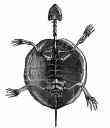 |
Al citar este artículo, favor de hacerlo así: Jesse Lerner, "A Fevered Dream of Maya: Robert Stacy-Judd", La tortuga marina, historia en extinción, año 2001, https://tortugamarina.tripod.com/ |